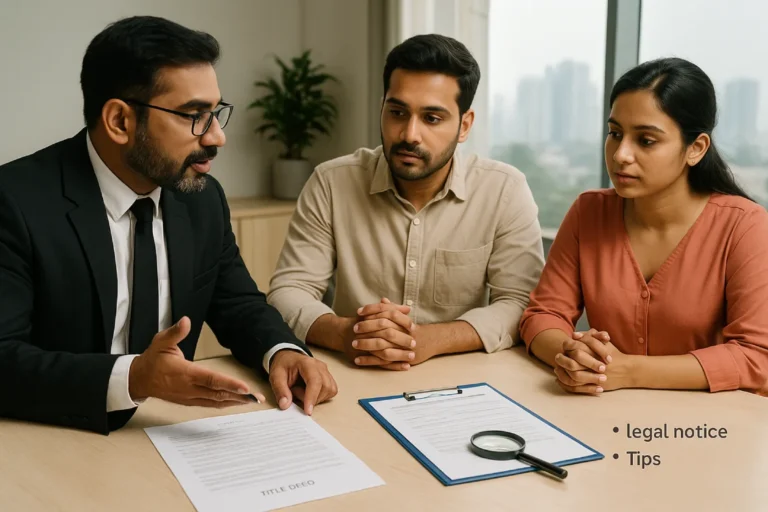Encumbrance Certificate in Karnataka: 7 Easy Steps
An Encumbrance Certificate in Karnataka (EC) lists registered transactions that affect a property, such as sales, mortgages, gifts, releases, and leases, during a period you choose. You need it for most purchases and home loans. You can apply through Encumbrance Certificate Online services on the Kaveri portal or at the Sub‑Registrar Office (SRO). In Bengaluru, many buyers rely on an Encumbrance Certificate in Bangalore for quick checks, then confirm details with a title search.
Want a full due diligence pack beyond EC? Our property team handles title verification, approvals, and risk flags. See our property lawyers in Bangalore for title due diligence.
Why the EC Matters for Every Buyer
A clean EC reduces risk. It shows if a bank or anyone else has a registered claim on the property. Lenders ask for it. Buyers use it to confirm the title chain.

Use a long search window, often 20–30 years, or from the date the layout formed. For city deals, an Encumbrance Certificate in Bangalore is often available on the Kaveri system. Older or rural records may require manual checks at the SRO.
If your purchase involves family settlements or divorce‑linked shares, align the EC with the legal chain. For context on how family events affect title and shares, read our guide on the division of property after divorce.
Encumbrance Certificate in Karnataka: What It Shows
Understand the exact fields captured in an EC in Karnataka transaction type, parties, document details, property schedule, and amounts so you can quickly verify title links.
The EC usually includes:
- Type of transaction: sale, gift, mortgage, lease, release, partition.
- Parties: seller, buyer, mortgagor, mortgagee.
- Document details: number, year, book, SRO.
- Property schedule: boundaries, measurements, identifiers as per deed.
- Consideration/amount: sale price or loan amount, where recorded.
A period with no registered dealings appears as a NIL EC for that span.
What the EC Does Not Show
The EC is vital, but it does not cover everything:
- Unregistered agreements (e.g., unregistered sale agreement) do not appear.
- Court orders or attachments may not show unless registered at the SRO.
- Society, tax, or maintenance dues are usually outside the EC scope.
- Pending RERA/consumer disputes won’t show unless tied to a registered entry.
Because of these gaps, pair the EC with a title review and litigation search. Our civil team deals with boundary disputes, injunctions, and related suits. See civil lawyers in Bangalore for property disputes.
Types of EC You’ll Hear About
- EC with entries (encumbered): shows registered charges or transfers in your search window.
- NIL EC: no registered encumbrances for the chosen period.
Banks often require a NIL EC for home‑loan processing. Buyers use it as a quick “first filter.”
How to Apply: Encumbrance Certificate Online vs. SRO Visit

Official resource: See the Kaveri Online Services EC FAQ for eligibility, search inputs, and download steps.
You can get EC online in Karnataka through Kaveri Online Services or apply at the SRO.
Option A Encumbrance Certificate Online (Kaveri)
- Register / Sign in to the Kaveri portal.
- Select the Encumbrance Certificate Online service.
- Enter SRO jurisdiction, property number/schedule, and owner details if needed.
- Choose the period (e.g., 01‑01‑1995 to today) and pay the fee.
- Download the EC when issued (instant for some records; others need processing).
This is common for an Encumbrance Certificate in Bangalore, where digitized records are robust.
Option B: Apply at the Sub‑Registrar Office (SRO)
- Visit the SRO for the property’s location.
- Provide the property schedule and the search period you want.
- Pay the fee and keep the receipt.
- Collect the EC when ready.
Documents and Details to Keep Handy
Keep these essentials handy to speed up your Encumbrance Certificate in Karnataka request and avoid errors: sale deed or property schedule, property identifiers, owner details, ID proof, and a 20–30 year search period.
- Latest sale deed/parent deed or the property schedule copy.
- Survey/site/flat number; project, phase, and block details.
- Names of current owner(s).
- Your ID proof (for applications at SRO counters).
- Search period (ideally 20–30 years or from layout formation).
Timelines and Fees (What to Expect)
For recent, digitized records, the EC in Karnataka is often ready in 3–7 working days. For scope and process notes, refer to the Department of Stamps & Registration’s EC guide for post‑2004 records. Manual searches for older records can take longer. Fees are modest and scale with years searched. Keep buffer time, especially near month‑end when counters are busy.
How to Read an EC Without Missing Red Flags
Use this quick checklist to read an EC in Karnataka, match the schedule, trace title links, and confirm mortgage releases before you sign.

Use this checklist:
- Match the schedule: boundaries, measurements, and identifiers should match your sale deed.
- Trace the title chain: every sale, release, or gift should connect in sequence.
- Watch for mortgages: look for registered releases or bank NOCs after any loan.
- Check dates: the seller must have acquired the title before agreeing to sell to you.
- Period length: Use a long enough window; short searches hide older encumbrances.
If something looks off, do not ignore it. Ask for supporting documents or a legal review.
Beyond the EC: Build a Safer Due‑Diligence Stack
An Encumbrance Certificate in Karnataka is your first screen. Add these layers:
- Title chain review: deeds for 30 years or since layout formation.
- Khata/municipal records: BBMP/BMRDA/CMC extracts, mutations, and tax paid receipts (see BBMP Khata Services).
- Plan/approval checks: sanctioned plans, occupancy/completion certificates; verify registration on Karnataka RERA’s project list.
- Litigation search: local courts and online repositories for suits and injunctions (search eCourts Services case status).
- Charge verification: bank letters and release deeds to close historic loans.
Need help assembling this pack? Contact our property lawyers in Bangalore for a clear, written risk report before you pay a token advance.
Get EC Online Karnataka
Follow these simple steps to apply for an Encumbrance Certificate online in Karnataka via the Kaveri portal.
- Open Kaveri Online Services and log in.
- Choose Encumbrance Certificate Online.
- Enter the SRO area and property schedule or number.
- Pick a long period (e.g., 1995 to present).
- Pay online and submit.
- Download the EC when ready.
If nothing appears, try alternate spellings of the layout or owner’s name, extend the search period, or contact the SRO.
Common Mistakes to Avoid
Avoid these easy‑to‑miss errors when getting an EC in Karnataka: search long periods, confirm mortgage releases, and don’t rely on a NIL EC alone.
- Short search windows: always search widely for the EC in Karnataka.
- Assuming NIL EC means zero risk: still verify khata, plans, and taxes.
- Skipping release deeds: ensure closure after any mortgage.
- Typos in details: even small errors can miss entries.
- Not syncing names: seller names must match across deeds and the EC.
How Property Lawyers Actually Help

Our role is to reduce your risk and speed up decisions:
- Verify EC entries and connect them to the title chain.
- Find gaps (missing links, late registrations, unclosed mortgages).
- Read every deed for easements, rights of way, and carve‑outs.
- Check compliance (sanctioned plans, OC/CC, khata, taxes).
- Report in plain English with a yes/no and next steps.
If the matter involves civil disputes, our litigation team can step in early to learn more from civil lawyers in Bangalore for property disputes.
FAQs
What is an Encumbrance Certificate (EC) and why is it mandatory for property transactions in Karnataka?
An Encumbrance Certificate in Karnataka lists registered transactions that affect a property within a chosen period. Banks and buyers require it to reduce risk and confirm that no registered charge blocks the deal.
Can EC be used as proof of property ownership?
No. The EC is not ownership proof. The latest registered sale deed, plus municipal or revenue records, usually establishes ownership.
What is a NIL Encumbrance Certificate, and when is it required?
A NIL EC means no registered encumbrances for the period searched. Banks often ask for it during home‑loan processing. Buyers use it as a quick title screen.
How long does it take to get an EC in Karnataka?
For digitized records, expect about 3-7 working days. Manual or legacy records can take longer, depending on the SRO.
How can property lawyers assist with EC verification, title search, and document review?
We read the Encumbrance Certificate in Karnataka, trace every title link, confirm releases for mortgages, check approvals and khata, and flag litigation or compliance risks. You get a clear action plan.
Buy With Confidence, Not Doubt
You want a clean purchase, easy financing, and no hidden claims. An Encumbrance Certificate in Karnataka is a strong first check, but it is not the whole picture. If the Kaveri portal feels confusing, if entries do not match, or if you are unsure about NIL vs. encumbered EC, talk to us. Speak with our property team today. We will run your Encumbrance Certificate in Bangalore, verify the title chain, and deliver a simple, written yes/no with steps to fix issues so you avoid delays and costly disputes. Start with our property due diligence and title verification in Bangalore.



